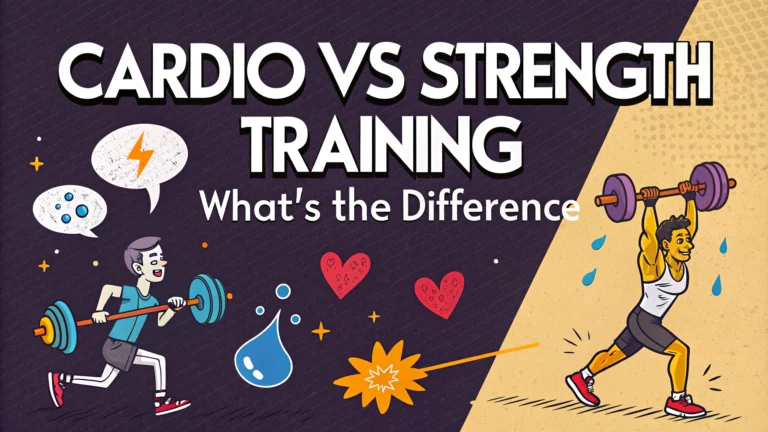Exercise selection can make or break your fitness goals. **Cardio** and **strength training** each offer unique benefits, and understanding their differences helps create an effective workout plan tailored to your needs.
While **cardio** builds endurance and burns calories during workouts, **strength training** increases muscle mass and boosts metabolism long-term. The right combination depends on specific fitness objectives, current health status, and lifestyle factors.
Key Differences in Exercise Types
- **Cardio**: Continuous movement that elevates heart rate (running, cycling, swimming)
- **Strength**: Resistance exercises using weights, bands, or body weight
- **Energy Systems**: Cardio uses aerobic, strength uses primarily anaerobic
- **Recovery Time**: Cardio typically needs less recovery between sessions
Benefits of Cardiovascular Training
- **Heart Health**: Improves cardiovascular efficiency
- **Endurance**: Builds stamina for daily activities
- **Weight Management**: Burns calories during exercise
- **Mental Health**: Releases mood-boosting endorphins
| Benefit Type | Cardio | Strength |
|---|---|---|
| Calorie Burn | Higher during workout | Higher post-workout |
| Muscle Impact | Maintains | Builds |
| Recovery Need | 24-48 hours | 48-72 hours |
Strength Training Advantages
- **Muscle Growth**: Increases lean muscle mass
- **Metabolism Boost**: Raises resting metabolic rate
- **Bone Health**: Improves bone density
- **Functional Fitness**: Enhances daily movement patterns
“The best exercise program combines both cardio and strength training in a way that aligns with your personal goals and schedule.”
Creating an Effective Combined Routine
A balanced workout schedule maximizes the benefits of both training styles. Start with 2-3 strength sessions and 2-3 cardio workouts per week, allowing proper recovery between similar activities.
- **Alternate Days**: Schedule strength and cardio on different days
- **Split Sessions**: Separate cardio and strength by at least 6 hours
- **Priority First**: Do your primary goal exercise when fresh
Choosing Based on Your Goals
Match your exercise selection to specific fitness objectives. Your current fitness level and time availability will influence the ideal program balance.
| Goal | Recommended Focus | Training Split |
|---|---|---|
| Weight Loss | 60% cardio, 40% strength | 3-4x cardio, 2x strength |
| Muscle Gain | 70% strength, 30% cardio | 3-4x strength, 2x cardio |
| General Fitness | 50% each | 2-3x each |
Common Myths and Misconceptions
Understanding exercise facts helps make informed training decisions. Research-based evidence guides better workout choices.
- **Myth**: Cardio burns more fat than strength training
- **Truth**: Both contribute to fat loss differently
- **Myth**: Weights make women bulky
- **Truth**: Women lack testosterone for significant bulk
“Success comes from consistency in both nutrition and exercise, not from choosing one type of training over another.”
Making the Right Choice for You
Consider your schedule, preferences, and physical limitations when designing your program. Start gradually and adjust based on progress and enjoyment.
Action Steps to Get Started
- **Assess Current Fitness**: Get a professional evaluation
- **Set Clear Goals**: Define specific, measurable objectives
- **Start Small**: Begin with 2-3 sessions per week
- **Track Progress**: Monitor improvements in strength and endurance
- **Adjust As Needed**: Modify your program every 4-6 weeks
Regular evaluation and adjustment of your exercise program ensures continued progress toward your fitness goals. Focus on consistency and proper form rather than perfect program design.
Frequently Asked Questions: Cardio vs Strength Training
1. What are the main differences between cardio and strength training?
Cardio training focuses on improving cardiovascular endurance through continuous movement, while strength training builds muscle mass and bone density through resistance exercises. Key differences include:
- Energy systems used
- Impact on muscle tissue
- Calorie burn patterns
- Equipment requirements
2. Which burns more calories: cardio or weight training?
Cardio typically burns more calories during the actual workout, but strength training creates an afterburn effect (EPOC) that increases calorie burn for up to 48 hours post-workout.
3. Is it better to do cardio before or after weights?
Research suggests doing strength training before cardio if your primary goal is building strength and muscle. This ensures you have maximum energy for proper form and technique during weight training.
4. How much strength training vs cardio for weight loss?
A balanced approach includes:
| Training Type | Weekly Frequency |
|---|---|
| Strength Training | 2-3 sessions |
| Cardio | 3-5 sessions |
5. Can you build muscle doing only cardio?
While cardio can maintain existing muscle, significant muscle growth requires progressive resistance training. Cardio alone is insufficient for muscle building.
6. What’s the best cardio to preserve muscle mass?
Low-intensity steady-state (LISS) cardio and high-intensity interval training (HIIT) in moderation are optimal for maintaining muscle while improving cardiovascular fitness.
7. How long should cardio be after strength training?
Keep cardio sessions to 20-30 minutes after strength training to avoid interfering with muscle recovery and growth.
8. Will combining cardio and weights slow muscle growth?
Excessive cardio can impair muscle growth, but moderate cardio (2-3 sessions weekly) won’t significantly impact muscle gains when combined with proper nutrition and recovery.
9. What’s better for belly fat: cardio or strength training?
A combination is most effective:
- Strength training: Increases metabolism and builds muscle
- Cardio: Creates caloric deficit
- Proper nutrition: Essential for fat loss
10. How to combine cardio and strength training for beginners?
Start with:
- 2 full-body strength sessions weekly
- 2-3 moderate cardio sessions (20-30 minutes)
- Rest days between strength workouts
- Focus on form and technique
11. Does cardio after weights affect testosterone levels?
Moderate cardio after weights doesn’t significantly impact testosterone levels. However, excessive endurance training can lower testosterone production.
12. What’s the optimal rest period between cardio and strength days?
Allow 6-24 hours between intense cardio and strength sessions for optimal recovery and performance.



















